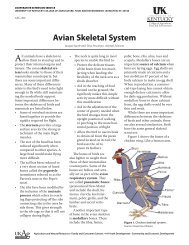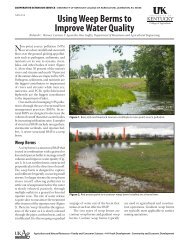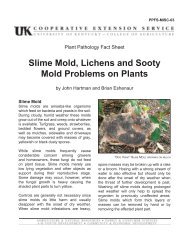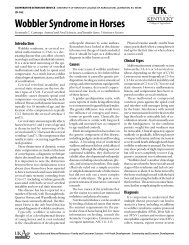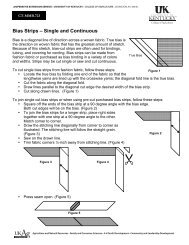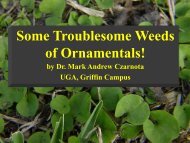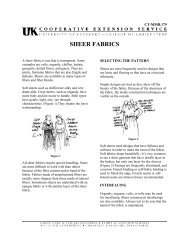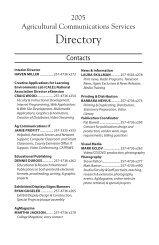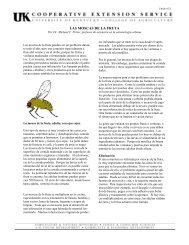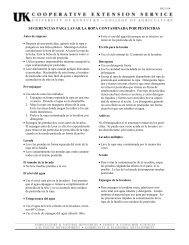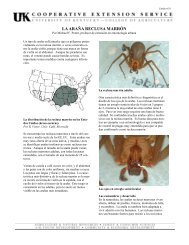Pruning Landscape Shrubs - UK College of Agriculture - University ...
Pruning Landscape Shrubs - UK College of Agriculture - University ...
Pruning Landscape Shrubs - UK College of Agriculture - University ...
You also want an ePaper? Increase the reach of your titles
YUMPU automatically turns print PDFs into web optimized ePapers that Google loves.
<strong>Pruning</strong><br />
<strong>Landscape</strong> <strong>Shrubs</strong><br />
AGRICULTURE & NATURAL RESOURCES FAMILY & CONSUMER SCIENCES<br />
4-H/YOUTH DEVELOPMENT COMMUNITY & ECONOMIC DEVELOPMENT<br />
HO-59
<strong>Pruning</strong> <strong>Landscape</strong><br />
<strong>Shrubs</strong><br />
<strong>Shrubs</strong> placed on your home grounds should be kept<br />
healthy and vigorous so they will continue to be attractive<br />
in form, height, flower, and fruit. This means annual pruning<br />
is as important as regular watering and fertilizing <strong>of</strong><br />
your plants.<br />
People <strong>of</strong>ten wait until their plants have grown beyond<br />
their bounds—too tall or too bushy—before they use their<br />
pruners. Often it’s too late to salvage shrubs at this point.<br />
Rather than allowing this to happen, shrubs should be<br />
checked every year and pruning attention given to the following<br />
situations.<br />
Figure 1.—TOP: Yellow-twig dogwoods are like many other<br />
multistemmed shrubs—they develop abundant suckers, darkcolored,<br />
thick older branches, and declining branches with<br />
telltale unthrifty-looking bark. All <strong>of</strong> these types <strong>of</strong> branches<br />
should be removed annually. In general, any 3-year-old<br />
wood should also be removed. BOTTOM: This is the same<br />
plant after pruning. A large number <strong>of</strong> branches were<br />
removed without changing the shrub's form or multistemmed<br />
character. Note that no stubs remain.<br />
RE McNiel, WL Mesner, WM Fountain, WD Dunwell<br />
2<br />
Prune Dense Growth Which<br />
Needs to Be Thinned<br />
Air and light are necessary for leaves on inside and lower<br />
portions <strong>of</strong> the plant to function. As plants become crowded,<br />
light, moisture, and air infiltration are reduced. Don’t wait<br />
until plants are severely overcrowded to start thinning them;<br />
make cuts annually when you start seeing reduced growing<br />
space.<br />
Figure 2.—The pruning lopper for removing branches at<br />
soil level is correctly placed here. The entire suckering<br />
branch is removed from this Viburnum sp.
Dead wood and unthrifty branches should be pruned as<br />
soon as they appear, since they detract from the overall<br />
appearance <strong>of</strong> your plant.<br />
Prune for Best Show <strong>of</strong> Flowers and to<br />
Encourage Abundant Fruit Production<br />
Give branches enough room to display flowers and fruits<br />
without interference from other branches that cross over or<br />
are spaced too closely. Usually spaces <strong>of</strong> 8 to 12 inches<br />
between branches are best for good flower and fruit size.<br />
This ample space also helps to reduce insect and disease<br />
problems occurring on the flowers and fruits.<br />
Figure 3a.—Look for dark, discolored areas and cracked<br />
bark as indications <strong>of</strong> diseased branches. These branches<br />
need to be removed as such symptoms appear.<br />
Figure 3b.—A pruning saw is shaped to fit into small areas<br />
like this one. It should be positioned so as not to rub on<br />
nearby valuable branches. <strong>Pruning</strong> saws, unlike carpenters'<br />
saws, cut on the pull stroke, thus making pruning easier.<br />
3<br />
Figure 3c.—Once the big part <strong>of</strong> the diseased branches is<br />
removed, you can position the saw better to take out the<br />
remaining stub as close to the soil line as possible.<br />
Figure 3d.—After diseased stems are removed, check for<br />
branches that cross over. As these branches expand in diameter<br />
they rub together, causing open wounds on both. Choose one to<br />
remove; in this case, the smaller branch is cut out.<br />
Figure 3e.—Removing diseased and crossover branches<br />
results in a desirable open character, such as with this<br />
multistemmed shrub.
Figure 4.—This Rose <strong>of</strong> Sharon shrub, though still small, is pruned each year to remove branches that are too close together.<br />
When it blooms, the number <strong>of</strong> flowers may be reduced, but generally each flower will be larger and showier. LEFT: Before<br />
pruning. CENTER: Correct cuts for removing branches so no stubs are left. RIGHT: After pruning has been done—notice<br />
opening <strong>of</strong> plant after excess growth has been pruned.<br />
Prune to Encourage Flower<br />
Production Every Year<br />
<strong>Pruning</strong> at the wrong time <strong>of</strong> year may reduce or even<br />
eliminate one season’s bloom. For this reason, follow these<br />
three guidelines in pruning your particular flowering shrubs.<br />
1. <strong>Shrubs</strong> that flower before June should be pruned<br />
during or immediately after flowering. They bloom on<br />
wood formed the previous summer. By pruning them right<br />
after they bloom, you are allowing maximum time before<br />
winter to develop the wood for next season’s show <strong>of</strong> flowers.<br />
If pruned during the winter or before flowering in the<br />
spring, flower buds are removed and blossoms are reduced<br />
or eliminated for the coming season. Examples <strong>of</strong> early<br />
flowering shrubs in this category are listed below.<br />
Spring flowering shrubs which should be pruned from<br />
after flowering until the end <strong>of</strong> June<br />
Scientific Name Common Name<br />
Berberis sp. Barberries<br />
Calycanthus floridus Sweet shrub<br />
Caragana sp. Pea shrub<br />
Chaenomeles sp. Flowering quince<br />
Cotinus coggygria Smoke tree<br />
Cornus mas Cornelian cherry<br />
Deutzia sp. Deutzias<br />
Forsythia sp. Forsythias<br />
Ilex sp. Hollies<br />
Kalmia latifolia Mountain laurel<br />
Kolkwitzia amabilis Beautybush<br />
Ligustrum sp. Privets or Ligustrums<br />
Lonicera sp. Honeysuckles<br />
Magnolia sp. Magnolias<br />
Philadelphus sp. Mock oranges<br />
Pieris sp. Pieris Andromedas<br />
Pyracantha sp. Firethorns<br />
Rhodendron sp. Azaleas and Rhododendrons<br />
Rhodotypus scandens Black jetbead<br />
Spiraea sp. Thunberg spirea, Bridalwreath spirea<br />
Styrax japonica Japanese snowball<br />
Syringa sp. Common, Chinese, and French lilacs<br />
Viburnum sp. Viburnums<br />
4<br />
Figure 5.—Forsythia bushes produce excessive growth at the<br />
base, and long weak shoots extend far into the air. After this<br />
shrub blooms, two types <strong>of</strong> pruning should be done. First,<br />
older branches should be thinned at the soil level. Once the<br />
large major stems are removed from the center, the remaining<br />
long shoots should be shortened by heading back cuts to an<br />
outside facing branch or bud. The outside facing branchlet<br />
will elongate in the direction which it presently faces.
2. <strong>Shrubs</strong> that flower after June first should be pruned<br />
in the winter or spring before new growth begins. They<br />
bloom on wood formed during the current spring or summer.<br />
Examples <strong>of</strong> summer flowering shrubs are listed below.<br />
Summer flowering shrubs which should be<br />
pruned before spring growth begins<br />
Scientific Name Common Name<br />
Acanthopanax sieboldianus Fiveleaf aralia<br />
Abelia grandiflora* Glossy abelia<br />
Buddleia davidii* Butterflybush<br />
Callicarpa sp. Beautybush<br />
Clematis sp. Clematis<br />
Clethra alnifolia Summersweet clethra<br />
Hibiscus syriacus Rose <strong>of</strong> sharon<br />
Hydrangea arborescens Hills <strong>of</strong> snow<br />
‘Grandiflora'<br />
hydrangea<br />
Hydrangea paniculata Peegee hydrangea<br />
‘Grandiflora'<br />
Hydrangea quercifolia Oakleaf hydrangea<br />
Lagerstroemia indica Crape myrtle<br />
Rosa hyb. Hybrid tea rose<br />
*Glossy abelia and butterflybush require considerable<br />
pruning. Prune before spring growth and again after it<br />
blooms.<br />
Figure 6.—This Hills <strong>of</strong> Snow hydrangea blooms on new<br />
wood. Some people mow it <strong>of</strong>f with a lawnmower in late fall<br />
or early spring. This hydrangea needs to be cut completly<br />
back before growth starts in the spring. TOP: Before<br />
pruning. BOTTOM: After pruning.<br />
5<br />
3. Certain shrubs may be pruned lightly before and<br />
after flowering. This will <strong>of</strong>ten increase flowering and<br />
fruit production and may result in a second bloom during<br />
the year. Examples <strong>of</strong> this group are listed below.<br />
<strong>Shrubs</strong> which may be pruned both before and after bloom<br />
Scientific Name Common Name<br />
Abelia grandiflora Glossy abelia<br />
Buddeia davidii Butterflybush<br />
Cornus sericea Red twig dogwood<br />
Cotoneaster apiculatus Cranberry cotoneaster<br />
Cotonester divaricatus Spreading cotoneaster<br />
Cotoneaster multiflorus Multiflora cotoneaster<br />
Mahbonia aquifolium Oregon grapeholly<br />
Spiraea bumalda Anthony Waterer and frobel spirea<br />
Symphoricarpos albus Snowberry<br />
Symphoricarpos chenaulti Chenault coralberry<br />
Wiegela florida Wiegela<br />
Prune to Direct Growth—To Shape<br />
Plants the Way You Want<br />
Knowing how plants respond to pruning helps you shape<br />
plants to the form and size you want. Every time you<br />
pinch back growth with your fingers or make a pruning<br />
cut with shears, you stop plant growth in one direction<br />
and start it in another. Always prune to a growing<br />
point which faces in the direction you want the plant to<br />
develop.<br />
Figure 7a.—Before pruning. Hollies (like this Foster #2<br />
Holly) have a compact pyramidal growth habit.<br />
Occasionally, pruning cuts are necessary to keep this<br />
desirable shape. You see two branches—one on the left, one<br />
on the right—which tended to grow faster than the other<br />
branches on the tree. Removal <strong>of</strong> these branches returns the<br />
plant to a desirable shape, and no unsightly stubs are left. In<br />
fact, it is hard to see where the cuts were made.
7B: Removal <strong>of</strong> one <strong>of</strong> the branches showing erratic growth.<br />
7C: After pruning.<br />
6<br />
Prune to Unusual Forms (Espalier,<br />
Topiary)<br />
Plants that you train for decorating purposes require pruning<br />
more <strong>of</strong>ten than once a year. Espaliering is the practice<br />
<strong>of</strong> training a tree or shrub to grow flat. Almost any tree<br />
or shrub can be trained flat by continually removing growing<br />
points that go in unwanted directions. Allow the rest <strong>of</strong><br />
the growing points to develop in their own way.<br />
Before placing a plant right next to your house for<br />
espaliering, it may be wise to place an iron or wooden<br />
support a few inches away from the house if you suspect<br />
you will want to remove the plant some day. This prevents<br />
any disfiguration <strong>of</strong> the wall from roots or holdfasts <strong>of</strong> the<br />
plant on your brick or wooden walls.<br />
Topiary is a shearing technique occasionally done on<br />
boxwood, juniper, pyracantha, yew, and privet. Part the<br />
branches to find a basic form you can work with. Cut <strong>of</strong>f<br />
limbs you don’t want. Wherever you want to form a clump,<br />
leave some side branches and shear them to the outline<br />
you desire. Leave a clump at the end <strong>of</strong> each branch you<br />
plan to keep, and shape the branchlets to the desired form.<br />
Remove all twigs and leaves along branches between<br />
clumps. If clumps aren’t as full as you’d like, be patient.<br />
Each season new branches and leaves will fill in the areas.<br />
Some <strong>of</strong> these will need to be snipped or rubbed <strong>of</strong>f.<br />
Figure 8.—Pyracantha sp. (firethorn) is a popular plant for<br />
growing on walls. TOP: a carefully pruned Pyracantha sp. with<br />
neat, well-placed branches. BOTTOM: A closeup <strong>of</strong> the same<br />
plant with arrows to indicate where to pinch new growth.
Figure 9.—Summer and winter scenes <strong>of</strong> juniper topiary. Overgrown junipers are good candidates for this type <strong>of</strong> selective<br />
ornamental pruning. Don't expect your plant to look like these one year after you start topiary pruning, but with annual<br />
care, they will assume similar desirable form in several years.<br />
Prune to Transform <strong>Shrubs</strong> into Trees<br />
Many shrubs can be transformed into single-stemmed or<br />
multistemmed trees. Remove as many vertical stems as you<br />
wish (to one superior stem or several strong stems). Then<br />
remove side branches between ground level and head<br />
height. Old shrubs can take on a new look and interest as<br />
small trees. In addition, you are opening the bottom area<br />
for new plantings.<br />
7<br />
Figure 10.—Remove unwanted side branches and suckers<br />
the first year. The "tree top" can be shaped later.
Figure 11.—This European cranberry viburnum was a<br />
mass <strong>of</strong> branches clumped tightly together. TOP: In an effort<br />
to reshape the plant once more into a healthy-looking, open,<br />
less cluttered specimen, the multistemmed shrub was made<br />
into a four-trunked tree. BOTTOM: Branches in the top <strong>of</strong><br />
the shrub were thinned; additional thinning and reshaping<br />
are needed in subsequent years to achieve a desirable form.<br />
8<br />
Prune to Get Rid <strong>of</strong> Freeze Damage<br />
Before removing what looks like freeze damage, make<br />
sure that’s what it is. Examine stems for live leaf buds.<br />
Buds that are withered and brown inside when you cut<br />
them open are dead. Also, check the cambium layer between<br />
the bark and heartwood. Scrape through the bark<br />
with your fingernail or a dull knife. Brown tissue is dead;<br />
green tissue is alive. Once you locate the first live bud and<br />
live cambium in the stem, prune branch tips to that point<br />
<strong>of</strong> live tissue.<br />
The roots and base <strong>of</strong> plants that apparently have been<br />
killed to the ground should be left for at least one year.<br />
Sometimes they have buds just below the soil surface that<br />
will activate and grow.<br />
Conifers that show brown needles and bare twigs in spring<br />
may be suffering from freeze damage. If one-third or fewer<br />
needles have dropped and buds aren’t destroyed, the shrub<br />
should recover quickly. After new growth starts, remove twigs<br />
that have totally dropped their needles. If the inside <strong>of</strong> the<br />
twig is brown, it’s dead; if it’s green, it’s alive.<br />
Where more than two-thirds <strong>of</strong> the needles have dropped,<br />
careful, selective pruning for two or more years may help<br />
bring the plant into decent shape and health. Hopefully,<br />
dormant side buds will activate when dead terminals are<br />
removed and new leaders can be developed from these<br />
side branches.<br />
<strong>Pruning</strong> Conifers<br />
Evergreen conifers fall into two broad categories. Spruce,<br />
fir, and most pines are whorl-branching types with branches<br />
radiating out from the trunk. Junipers, hemlocks, Taxus<br />
(yews), and arborvitae are random-branching conifers with<br />
branches sprouting in a random fashion from the trunk or<br />
roots. If the right-sized plant is used in the first place, little<br />
or no pruning is usually required on conifers.<br />
On whorl-branching types <strong>of</strong> conifers, you may<br />
choose to selectively prune back to another branch or bud.<br />
You can induce tip growth and branching by pinching back<br />
candles (the candle-like new stem growth which is produced<br />
in April and May) about halfway. Never damage the<br />
central leader on whorl-branching types unless you have a<br />
very good reason. If the leader is broken in some manner,<br />
you can vertically support and tie one <strong>of</strong> the next lower<br />
branches and try to train it as a new leader. Another alternative<br />
is to wait and allow new growth to take over and<br />
dominate in the vertical direction.
Shape random-branching conifers by taking undesirable<br />
branches out altogether. If you wish to shorten only<br />
a branch, cut it to a bud or side branch. Make sure never to<br />
cut beyond the last green growth unless you plan to remove<br />
the entire branch.<br />
Figure 12.—If an evergreen shrub has been pruned to a<br />
more formal shape, the new spring and summer growth<br />
should be cut back, preferably one branch at a time. By<br />
removing each excessively long branch individually, you<br />
can carefully cut to an existing side branch or an outfacing<br />
bud. TOP: During pruning. BOTTOM: After pruning.<br />
9<br />
Figure 13.—Yews typically produce abundant new shoots<br />
each spring. Many people shear these shrubs with an electric<br />
clipper in order to save time. The result is an unnatural<br />
appearance, injured branch tips and buds, and dense,<br />
clustered, dwarfed growth on the branch ends. This dense<br />
growth allows little or no light to reach the center <strong>of</strong> the<br />
plant; therefore, the center dies, leaving only a thin veneer <strong>of</strong><br />
green on the outside <strong>of</strong> the plant.<br />
Figure 14.—If you want to avoid the problems <strong>of</strong> shearing<br />
hedges mentioned above, make cuts similar to this<br />
technique. Clip each long shoot individually to a side<br />
branch as shown or to one <strong>of</strong> the outside facing buds<br />
(marked by arrow).<br />
Figure 15.—This yew has been completely pruned, one<br />
branch at a time. Note that the uninjured healthy buds are<br />
the natural appearance <strong>of</strong> the plant.
<strong>Pruning</strong> Equipment<br />
Not only are the many types <strong>of</strong> pruning tools overwhelming<br />
to beginning home landscape managers, but the wide<br />
ranges in quality <strong>of</strong> tools are also puzzling. For most <strong>of</strong><br />
you, however, this problem can be simplified: start out<br />
with your thumb and forefinger (the best tools for pinching<br />
back new growth), a hand pruning shear, a pruning saw,<br />
and a hand lopper. Additional needs will become evident<br />
as your landscaping and pruning interests expand.<br />
Look for good quality and workmanship in tools, since<br />
they should last a lifetime. Choose the right tool for the<br />
right job. If a branch is larger than 1/2 inch in diameter, the<br />
hand pruning shear is no longer an appropriate tool. Use<br />
either a saw or lopper. Keep your tools sharp, clean, and<br />
rust-free for best performance.<br />
One-Hand <strong>Pruning</strong> Shears—There are two basic designs<br />
<strong>of</strong> hand pruners. The anvil type cuts by the action <strong>of</strong><br />
a straight blade against an anvil, and the scissors type cuts<br />
by the hook holding the branch while the blade slices<br />
through it.<br />
Whichever type you choose, don’t buy poorly made<br />
models. They prove to be bad investments since they tend<br />
to make inferior cuts and need to be replaced within a<br />
short time.<br />
10<br />
Two-Hand Pruners or Lopping Shears—Long handles<br />
on lopping shears are the secret to their usefulness; they<br />
increase your reach and give you more cutting strength with<br />
added leverage. As with one-hand pruners, you have two<br />
styles to choose from: anvil and scissors type. Handles may<br />
be wooden, fiberglass, or tubular steel and may vary in length.<br />
<strong>Pruning</strong> Saw—Branches thicker than one inch should<br />
be cut with a pruning saw. <strong>Pruning</strong> saws are different than<br />
carpenter’s saws found in your garage. They are designed<br />
to cut on the pull stroke—and pulling is the most natural<br />
motion for cutting overhead branches. <strong>Pruning</strong> saws cut<br />
through green, fresh, wet wood very quickly if they are<br />
sharp.<br />
Basic Rules before<br />
Starting to Prune<br />
The following general guidelines apply to most plants<br />
in your garden:<br />
1.Study your plant from all angles before you make any<br />
cuts.<br />
2. The first order <strong>of</strong> business is to remove all dead, diseased,<br />
insect-ridden, storm-damaged, and winter-killed wood.<br />
3.Once this is done, you can spot undesirable branches:<br />
crossovers, suckers, sprouts, branches that are too low<br />
or too long. These should be removed.
4.Never leave stubs. All cuts should be made back to<br />
or just above some growing point, preferably to<br />
some outward growing point. If you always prune<br />
to some growing point, you won’t go too far wrong.<br />
New growth will continue to originate from cut areas.<br />
11<br />
Figure 16.—Pinching <strong>of</strong> new growth is frequently done on<br />
conifers to make the branches fuller. A shears is used here<br />
instead <strong>of</strong> fingers, though either is appropriate. Notice that<br />
approximately one-half <strong>of</strong> the new candle is removed.
Three Basic Cuts<br />
Pinching—Pinching is usually done with your hands to<br />
remove stem tips <strong>of</strong> new growth. It is a good way <strong>of</strong> controlling<br />
plant size. If you pinch out the stem tip, most <strong>of</strong> its<br />
share <strong>of</strong> energy becomes available to other growing tips<br />
and buds. It <strong>of</strong>ten makes your plant appear fuller.<br />
Thinning—Thinning involves complete removal <strong>of</strong> entire<br />
branches back to a main branch, to the trunk or to the<br />
soil line.<br />
Heading Back—Heading back is shortening branches<br />
by cutting them to a good bud or lateral branch.<br />
On most plants you will use a combination <strong>of</strong> all three<br />
pruning techniques: pinching, thinning, and heading back.<br />
It’s the surest way <strong>of</strong> shaping plants into attractive, healthy<br />
specimens.<br />
Educational programs <strong>of</strong> the Kentucky Cooperative Extension Service serve all people regardless <strong>of</strong> race, color, age, sex, religion, disability, or national origin Issued in furtherance <strong>of</strong><br />
Cooperative Extension work, Acts <strong>of</strong> May 8 and June 30, 1914, in cooperation with the US Department <strong>of</strong> <strong>Agriculture</strong>, C Oran Little, Director <strong>of</strong> Cooperative Extension Service, <strong>University</strong><br />
<strong>of</strong> Kentucky <strong>College</strong> <strong>of</strong> <strong>Agriculture</strong>, Lexington, and Kentucky State <strong>University</strong>, Frankfort Copyright © 1999 for materials developed by the <strong>University</strong> <strong>of</strong> Kentucky Cooperative Extension<br />
Service This publication may be reproduced in portions or its entirety for educational or nonpr<strong>of</strong>it purposes only Permitted users shall give credit to the author(s) and include this<br />
copyright notice Publications are also available on the World Wide Web at: http://wwwcaukyedu Issued 8-1982, last printed 6-1999, 4000 copies, 41000 copies to date



